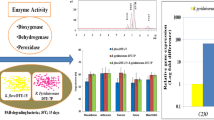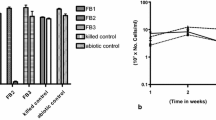Abstract
Polycyclic aromatic hydrocarbons (PAHs) are widespread pollutants and they can cause cancer, abnormality and mutation. Nine natural PAHs-degrading bacteria were obtained from polluted areas. These bacteria and the bacterial mixture can degrade phenanthrene, anthracene, pyrene and benzo[a]pyrene. The bacterial mixture can increase the degradation rates of several PAHs compounds, such as phenanthrene and benzo[a]pyrene, during the repaired process, and the degradation rates of these compounds were over 83%. The efficient degradation of PAHs should be the cooperation of key enzymes, such as dioxygenase and dehydrogenase, in the bacterial mixture. The main accumulated metabolite of above four PAHs was dibutyl phthalate detected by gas chromatography mass spectrometry, indicating that the degradation process of PAHs mainly represented the phthalic acid pathway in this work. And the toxicity of PAHs could be decreased by biodegradation. The effects of cultural factors, such as culture time, temperature, metal ions and pH on PAHs degradation efficiency were also studied.








Similar content being viewed by others
References
Akdoğana A, Gürsoy O (2020) Determination of four priority polycyclic aromatic hydrocarbons (4PAHs) by GC-MS in traditional Turkish yoghurts. Food Addit Contam A. https://doi.org/10.1080/19440049.2019.1707293
Aygun SF, Bagcevan B (2020) Determination of polycyclic aromatic hydrocarbons (PAHs) in drinking water of Samsun and it’s surrounding areas. Turkey J Environ Health Sci Engineer 17(2):1205–1212
Bouchez M, Blanchet D, Bardin V, Haeseler F, Vandecasteele JP (1999) Efficiency of defined strains and of soil consortia in the biodegradation of polycyclic aromatic hydrocarbon (PAH) mixtures. Biodegradation 10(6):429–435
Ciarkowska K, Gambuś F, Antonkiewicz J, Koliopoulos T (2019) Polycyclic aromatic hydrocarbon and heavy metal contents in the urban soils in southern Poland. Chemosphere 229:214–226
Csonga R, Ettmayer P, Auer M, Eckerskorn C, Eder J, Klier H (1996) Evaluation of the metal ion requirement of the human deoxyhypusine hydroxylase from HeLa cells using a novel enzyme assay. FEBS Lett 380(3):209–214
Dejonghe W, Berteloot E, Goris J, Boon N, Crul K, Maertens S, Höfte M, Devos P, Verstraete W, Top EM (2003) Synergistic degradation of linuron by a bacterial consortium and isolation of a single linuron-degrading Variovorax strain. Appl Environ Microbiol 69(3):1532–1541
Devi S, Sharma B, Kumar R, Kanwar SS (2020) Purification, characterization, and biological cytotoxic activity of the extracellular cholesterol oxidase produced by Castellaniella sp. COX J Basic Microbiol 60(3):253–267
Fernández-González R, Yebra-Pimentel I, Martínez-Carballo E, Simal-Gándara J (2012) Feed ingredients mainly contributing to polycyclic aromatic hydrocarbon and polychlorinated biphenyl residues. Polycyclic Aromat Compd 32(2):280–295
Ghosal D, Ghosh S, Dutta TK, Ahn Y (2016) Current state of knowledge in microbial degradation of polycyclic aromatic hydrocarbons (PAHs): a review. Front Microbiol 7:1369. https://doi.org/10.3389/fmicb.2016.01369
Giselle TF, Ana MM, François R, Miguel RL, Sofie T, Inge J, Jenny P, Jan C, Gilda GR, Robert C, Jaco V (2019) Biodegradation of polycyclic aromatic hydrocarbons by native Ganoderma sp. strains: identification of metabolites and proposed degradation pathways. Appl Microbiol Biotechnol. https://doi.org/10.1007/s00253-019-09968-9
Guo C, Dang Z, Wong Y, Tam NF (2010) Biodegradation ability and dioxgenase genes of PAH-degrading Sphingomonas and Mycobacterium strains isolated from mangrove sediments. Int Biodeterior Biodegrad 64(6):419–426
Haritash AK, Kaushik CP (2009) Biodegradation aspects of polycyclic aromatic hydrocarbons (PAHs): a review. J Hazard Mater 169(1–3):1–15
Huang Y, Chen J, Shu W (2014) Combined effects of dibutyl phthalate (DBP) and benzo(a)pyrene on fertility in male rats. J Geos & Environ Protect 2:167–172
Hussain A, Nada A, Murad H (2018) Development of QuEChERS method for the determination of polycyclic aromatic hydrocarbons in smoked meat products using GC-MS from qatar. J Anal Methods Chem 2018:1–11
Jie C, Zhang E, Liu E, Liu H, Yang X (2018) A 60-year historical record of polycyclic aromatic hydrocarbons (PAHs) pollution in lake sediment from Guangxi Province, Southern China. Anthropocene 24:51–60
Kobayashi K, Katz A, Rajkovic A, Ishii R, Branson OE, Freitas MA, Ishitani R, Ibba M, Nureki O (2014) The non-canonical hydroxylase structure of YfcM reveals a metal ion-coordination motif required for EF-P hydroxylation. Nucleic Acids Res 42(19):12295–12305
Li MT, Zhao XM, Zhang XF, Wu D, Leng S (2018) Biodegradation of 17β-estradiol by bacterial co-culture isolated from manure. Sci Rep 8(1):3787
Liang L, Song X, Kong J, Shen C, Huang T, Hu Z (2014) Anaerobic biodegradation of high-molecular-weight polycyclic aromatic hydrocarbons by a facultative anaero be Pseudomonas sp. JP1. Biodegradation 25(6):825–833
Liu YX, Yuan X, Liu ZY (2019) Optimization, purification, and characterization of hydroxylamine oxidoreductase from Acinetobacter sp. Y1. Biotechnol Appl Biochem 66(4):494–501
Luo A, Wu Y, Xu Y, Kan J, Qiao J, Liang L, Huang T, Hu Z (2016) Characterization of a cytochrome P450 monooxygenase capable of high molecular weight PAHs oxidization from Rhodococcus sp. P14. Process Biochem 51:2127–2133
Mallick S, Chakraborty J, Dutta TK (2011) Role of oxygenases in guiding diverse metabolic pathways in the bacterial degradation of low-molecular-weight polycyclic aromatic hydrocarbons: a review. Crit Rev Microbiol 37(1):64–90
Ng NT, Sanagi MM, Ibrahim WNW, Ibrahim WAW (2017) Agarose-chitosan-C18 film micro-solid phase extraction combined with high performance liquid chromatography for the determination of phenanthrene and pyrene in chrysanthemum tea samples. Food Chem 222:28–34
Nguyen TT, Ngam-Ek A, Jenkins J, Grover SD (1988) Metal ion interactions with phosphoenolpyruvate carboxylase from crassula argentea and zea mays. Plant Physiol 86(1):104–107
Qin W, Zhu Y, Fan FQ, Wang YY, Liu X, Ding AZ, Dou JF (2017) Biodegradation of benzo(a)pyrene by Microbacterium sp. strain under denitrification: degradation pathway and effects of limiting electron acceptors or carbon source. Biochem Eng J 121:131–138
Saito A, Iwabuchi T, Harayama SA (2000) Novel phenanthrene dioxygenase from Nocardioides sp. strain KP7: Expression in Escherichia coli. J Bacteriol 182(8):2134–2141
Singh SK, Haritash AK (2019) Polycyclic aromatic hydrocarbons: soil pollution and remediation. Int J Environ Sci Technol 16:6489–6512
Sorensen SR, Ronen Z, Aamand J (2002) Growth in coculture stimulates metabolism of the phenylurea herbicide isoproturon by Sphingomonas sp strain SRS2. Appl Environ Microbiol 68(7):3478
Stingley RL, Khan AA, Cerniglia CE (2004) Molecular characterization of a phenanthrene degradation pathway in Mycobacterium vanbaalenii PYR-1. Biochem Biophys Res Commun 322(1):133–146
Schleheck D, Knepper TP, Fischer K, Cook AM (2004) Mineralization of individual congeners of linear alkylbenzenesulfonate by defined pairs of heterotrophic bacteria. Appl Environ Microbiol 70(7):4053–4063
Talalay P, Dobson MM, Tapley DF (1952) Oxidative degradation of testosterone by adaptive enzymes. Nature 170(4328):620–621
Tepe Y, Dede ZT (2020) Concentrations of PAH Pollution in the Seawaters of Turkey The Handbook of Environmental Chemistry. Springer, Berlin. https://doi.org/10.1007/698_2020_502
Uzoekwe SA, Ikpesu TO (2020) Concentration distribution and ecological risk assessment of polycyclic aromatic hydrocarbon in Kolo Creek Niger-Delta Nigeria. Sci Rev 6(7):62–70
Vinas M, Sabate J, Espuny MJ, Solanas AM (2005) Bacterial community dynamics and polycyclic aromatic hydrocarbon degradation during bioremediation of heavily creosote-contaminated soil. Appl Environ Microbiol 71(11):7008–7018
Wang B, Wang Y, Dong F, Zhu J, Tan J, Fu X, Wei M, Li M (2016) Analysis and occurrence of polychlorinated biphenyls and polycyclic aromatic hydrocarbon in sludge dredged from a serious Eutrophic Lake, China. Procedia Environ Sci 31:860–866
Wong JWC, Lai KM, Wan CK, Ma KK, Fang M (2002) Isolation and optimization of PAH-degradative bacteria from contaminated soil for PAHs bioremediation. Water Air Soil Pollut 139(1–4):1–13
Xing YN, Li Z, Chen Y, Stock JB, Jeffrey PD, Shi YG (2008) Structural mechanism of demethylation and inactivation of protein phosphatase 2A. Cell 133(1):154–163
Xiong G, Draus E, Luo Y, Maser E (2009) 3alpha-Hydroxysteroid dehydrogenase/carbonyl reductase as a tool for isolation and characterization of a new marine steroid degrading bacterial strain. Chem Biol Interact 178:206–210
Xu M, Han S, Lu N, Zhang X, Liu J, Liu D, Xiong G, Guo L (2018) Degradation of oestrogen and an oestrogen-like compound in chicken faeces by bacteria. Water Air Soil Pollut. https://doi.org/10.1007/s11270-018-3984-x
Yebra-Pimentel I, Fernández-González R, Martínez-Carballo E, Simal-Gándara J (2012) Searching ingredients polluted by polycyclic aromatic hydrocarbons in feeds due to atmospheric or pyrolytic sources. Food Chem 135(3):2043–2051
Yebra-Pimentel I, Fernández-González R, Martínez-Carballo E, Simal-Gándara J (2014) Optimization of purification processes to remove polycyclic aromatic hydrocarbons (PAHs) in polluted raw fish oils. Sci Total Environ 470–471(2):917–924
Yuan SY, Wei SH, Chang BV (2000) Biodegradation of polycyclic aromatic hydrocarbons by a mixed culture. Chemosphere 41(9):1463–1468
Yuana SY, Huang IC, Chang BV (2010) Biodegradation of dibutyl phthalate and di-(2-ethylhexyl) phthalate and microbial community changes in mangrove sediment. J Hazard Mater 184(1–3):826–831
Zhang T, Xiong G, Maser E (2011) Characterization of the steroid degrading bacterium S19–1 from the Baltic Sea at Kiel. Germany Chem Biol Interact 191(1–3):83–88
Acknowledgements
This programme was financed by the Department of Jilin Province Science & Technology under [Grant Number 20190301055NY], the Development and Reform Commission of Jilin Province under [Grant Number 2019C055-2]; the Education Department of Jilin Province under [Grant Number JJKH20200323KJ] and the National Key Laboratory of Wetland Ecology and Vegetation Restoration, Northeast Normal University [Grant Number 2019-001].
Funding
This study was funded by the Department of Jilin Province Science & Technology under [Grant Number 20190301055NY]; the Development and Reform Commission of Jilin Province under [Grant Number 2019C055-2]; the Education Department of Jilin Province under [Grant Number JJKH20200323KJ]; the National Key Laboratory of Wetland Ecology and Vegetation Restoration, Northeast Normal University [Grant Number 2019–001].
Author information
Authors and Affiliations
Contributions
All authors contributed to the study conception and design. Material preparation, data collection by Miao Xu, Ming Wu, Yingyuan Zhang, Haitao Zhang, Wencong Liu and Guang Chen. Data analysis and arrange were performed by Miao Xu, Guangming Xiong and Liquan Guo. The first draft of the manuscript was written by Miao Xu and all authors commented on previous versions of the manuscript. All authors read and approved the final manuscript.
Corresponding author
Ethics declarations
Conflict of interests
The authors have no relevant financial or non-financial interests to disclose.
Additional information
Editorial responsibility: Maryam Shabani.
Rights and permissions
About this article
Cite this article
Xu, M., Wu, M., Zhang, Y. et al. Biodegradation of polycyclic aromatic hydrocarbons (PAHs) by bacterial mixture. Int. J. Environ. Sci. Technol. 19, 3833–3844 (2022). https://doi.org/10.1007/s13762-021-03284-4
Received:
Revised:
Accepted:
Published:
Issue Date:
DOI: https://doi.org/10.1007/s13762-021-03284-4




